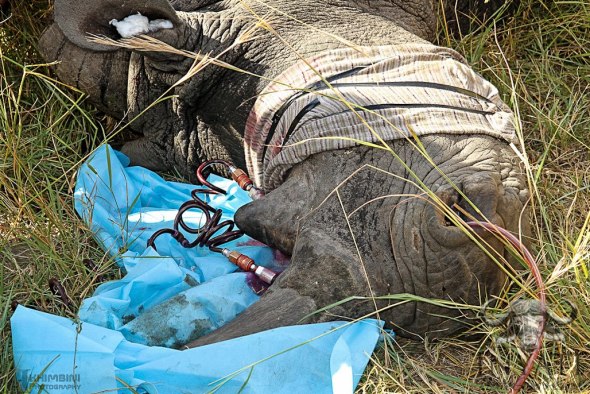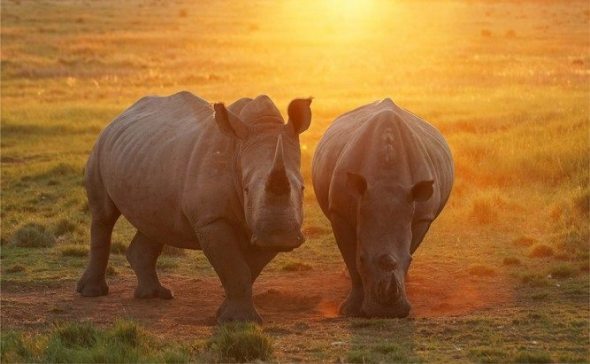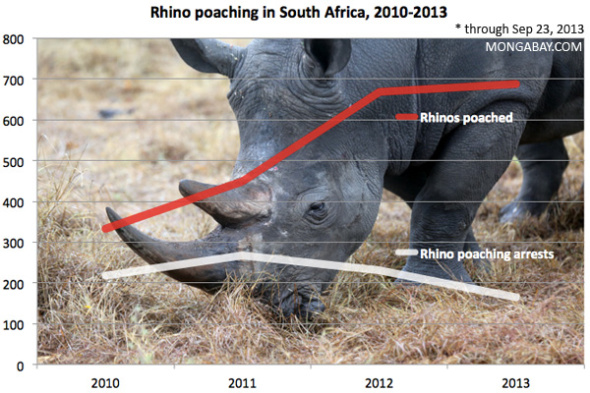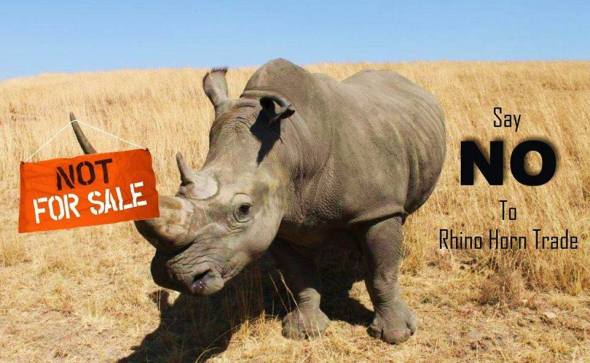Rhino Wars - Update 2013.
THE MOON is high on the Savannah tonight, humid, a deep distance roar of a Lion and cubs can be heard in the distance possibly feeding on their latest catch of impala or onyx. Then out of nowhere a glistening silvery giant appears with something small and pudgy tagging along. A Rhinoceros cow and it’s calf - a stunning sight in the moonlight high grasses - silent and airy the two pass without noticing I am only a few meters away. The feeling of excitement passes through me with a mad rush of adrenalin - then out of nowhere loud gun shots crackle in the distance - my brief moment of joy and happiness at seeing Mother Nature’s 50 million year old species is shattered - brought to my senses once again knowing that I’m embedded and armed in poacher land. WELCOME to SOUTH AFRICA - Home to 90% of the worlds largest dwindling Rhinoceros population..
Several months have passed since I have documented on the African Rhino poaching - months that I and countless others have seen endless poached Rhino’s increasing to double that of last years number - a total of 928 Rhinoceros have been barbarically poached for their horns that are sold on the Asian black market for some $40,000 - $80,000 a Kilogram. 928 and still we have until the new year before the full years tally of dead Rhinos can be officially worked and documented on. Will we see the big 1,000 this year? Unlikely but then only last year one Rhino was poached every 11-15 hours. Now we are losing them faster than they can reproduce one to three a week and in some cases up to 15. We are no longer fighting a war on poaching - we are battling to keep Mother Natures species alive and secure. THE Battle is being lost.
Back in March at the Conference of Parties held in Bangkok -Thailand there was talk on legalizing the still banned Rhino horn trade or at least releasing some of the stock piled Rhino horns that are held in secure vaults in South Africa. Talk was cheap though. However since March Hon Edna Molewa has decided to buddie up with the hunter fraternity that compromises rangers, veterinary staff, and agriculturists many pro-trade lobbyists from which she will asking Cites signatories to allow the trade ban to be lifted in the hope this will generate income, flooding funds into conservation to preserve our ionic species. Hon Edna Molewa quoted that all efforts to preserve the Rhino have failed and that the banned horn trade must no longer be a hushed subject. Little does she care though of the last mistakes on the partial legalization of the ivory trade that resulted in much income yet lack of Elephant preservation.
Back in 2008 the first officially sanctioned ivory auction in nearly a decade happened in Namibia, with opinion split on whether the sale will help or hurt efforts to stop elephant poaching.
The Namibian government sold almost eight tons of ivory for $1.2 million. Further to this China being the main buyer with Japan last then sold on that ivory to Asian buyers for ten times the price they purchased disgruntling buyers thus increasing poaching. South Africa, Mozambique and Zimbabwe followed suite and sold on their non-poached ivory again all sold on to mainly Chinese citizens at ten times the price via the Chinese government.
The sales supposedly helped in Namibia, for example, some of the money was spent in communities that have problems with elephants destroying crops or killing people. Did it actually stop poaching though and kill trade within Asia? No it did not. Did ANY funding actually go into Anti Poaching that year from which, yes, there was a slight decrease in Elephant poaching - this question seems to keep popping up now frequently due to the high amount of poached mega fauna and low conviction rates. However, no sooner after the sales of white gold - Elephant poaching skyrocketed. Are we really prepared to make the same mistake again? and if we do will poaching really rage out of control killing all Rhino - then seeing poachers turn on the last of the mega beasts - Elephants and Lions.
Over 35,000 Elephants have been lost since this second one of trade with the first in 1999 approved by the Convention on International Trade in Endangered Species of Wild Flora and Fauna. The African government seem to be forgetting exactly what “one of” truly means -
Dictionary entry overview: What does one-off mean?
• ONE-OFF (noun)
The noun ONE-OFF has 1 sense:
1. a happening that occurs only once and is not repeated
Familiarity information: ONE-OFF used as a noun is very rare. Are these “one off sales rare” no they are not, are they a one off?
Since 2000 we have lost a nauseating 2,704 Rhinoceros all to poaching. The highest peaks that we have seen were back in 2002 - 2003 - 2005 - 2006 - then came the real increase that saw some 83 poached for 2008, 122 poached 2009, 2010 skyrocketed to 333, with 448 for 2011 and over 445 just for the month of October in 2012. 2012 we lost over 668 Rhinoceros. December 18th 2013 and we are sat at 930 poached. The humble Rhinoceros cannot keep up with reproducing with this mass surge in poaching and at every angle.
Arrests have shot up all being mainly African poachers from the nations of Zimbabwe and Mozambique however we see little convictions and mainly bailed not jailed poachers that are free to roam back over the border in to their native lands. 2010 saw 140 arrested - 2011 saw 267 arrested - 2012 saw 232 arrested and for the year of 2013 we have a non-concluded arrest rate of just over 190 arrested. Roughly 829 poachers have been captured - 90% of them have not even been prosecuted or even seen a jail house. Yet Hon Edna Molewa and the DEA Deputy Minister brags this is good news. Whats good news about poachers roaming back over the border just to take out another Rhino one dares ask?
Edna Molewa and I quote stated “All avenues must be exhausted before we even go down the route of de-horning our Rhinos”. The Department of Environmental Affairs (DEA) has though forgotten what she stated (2013) and as explained will be approaching the Convention on International Trade in Endangered Species of Wild Flora and Fauna in 2016 to call for the ban on Rhino horn trade to be lifted.
All avenues have not been explored nor even “exhausted” as one such method of preserving our humble species is that of the Rhino Rescue Projects - horn treatment program that has seen outstanding results with only one Rhino dying. That single male bull sadly died from complications caused by sedating and old age. Fortunately the RRP has progressed from this, learnt and have successfully with no Rhinos dying treated the horns of many farmed and wild Rhinoceros. Whereas those that have been de-horned - have sadly still be poached.
On 20 December 2012, AFB Hoedspruit conducted the DNA sampling and Chemical Treatment of Rhinoceros Horns. AFB Hoedspruit was assisted by Lt Col Phillip Oosthuizen who initiated the project, Protract, Rhino Rescue Project who sponsored the treatment, the Green Kids, the Department of Environmental Affairs, the Veterinary Doctor Dr Van Niekerk and the Directorate Animal Health SAMHS.
During the last two months Five Rhinos have been poached and killed at Umhlametsi Private Nature Reserve on the farm Boston (North) adjacent to AFB Hoedspruit. In addition, prior to this there were recently three incidents of the breaching of security and an attempt to track and kill rhinos on Suikerkop (AFB Hoedspruit Buffer zone). This obviously calls for desperate measures to proactively implement strategies in order to safeguard the rhino population at AFB Hoedspruit.
TOPS Regulation Section 27 dd refers. The mentioned legislation necessitates that all rhinos in South Africa be micro chipped and included into a National database. Currently there are only two units within the SANDF that possesses white rhino populations.
AFB Hoedspruit also investigated the various options of safeguarding the rhinos and acknowledges the responsibility with regards to the sound management of this species. Various security aspects were addressed and frequent patrols and informal exercises are carried out on an adhoc basis to discourage and prevent potential killing or poaching of these animals. As there are very little additional options, AFB Hoedspruit proposed that the horns of all the SA Air Force (SAAF) rhinos be treated rather than dehorned in order to endeavor and stop any further attempts to kill these magnificent animals.
The horn treatment strategy as opposed to the dehorning of the rhino has the following advantages:
- Durability
- Longer lasting (3-4 years as opposed to 1 year when dehorned)
- Visible internally when used with dye
- Horn becomes redundant and unusable when treated
- Proactive if made well known (signs, publicity etc)
- To date – no killing/poaching of rhinos with treated horns
When the rhino is temporarily immobilized for treatment DNA sampling is conducted to ensure sound management of this precious species in the SAAF. Although there are normally significant costs involved in such project, AFB Hoedspruit liaised with other researchers working on different challenges affecting rhino population and engaged with Dr Lorinda Hern from the Rhino Rescue Project who approved and supported this project and gave their consent to conduct such program free of charge on both the SA Air Force (SAAF) units who owns rhino’s.
The idea of poisoning the horns was circumvented by the need to treat the horn. The treatment of the horns with a mixture of ectoparasitacides coupled with an indelible dye would go a long way to helping achieve the goal of protecting rhinos from poaching. It is also believed that the treatment could potentially neutralize a dual threat of rampant poaching and reduce the cruel reality of poaching.
In the ongoing war against rhino poaching, a holistic and multi-pronged approach is necessary to contribute significantly to reducing the poaching scourge and deter the poachers. 19 Squadron supplied a helicopter to spot the rhinos, then the veterinarian darted the rhinos. The ground crew and veterinary team of experts stabilized the rhinos after the treatment.
The Green Kids Initiative (GKI) consisting of school children from rural areas assist to raise awareness about rhino poaching provides environmental education for schools, encourage sustainable environmental living practices and help to create environmental consciousness in communities.
Why does International Animal Rescue Africa support this approach for ? We support it because it works and has stopped any such poaching incident occurring. de-horned Rhino though are still being poached even for a six inch stub. The problems that we are seeing now with de-horned Rhinos are that poachers will not just take the one Rhino down - but two or even three as this way they can abscond with at least an entire horn although not intact.
Rhino Rescue Project’s horn treatment program can be viewed here - What do you support - De-horning that will only see more Rhino poached - or horn treatment that has not seen (any Rhinoceros poached) since it began?.

SO do we support de-horning and give it a try knowing that the Rhino population is now in serious status decline? International Animal Rescue Foundation.org.uk and Speak Up For The Voiceless.org does not under any circumstance support de-horning nor do we acknowledge any so called benefits from the de-horning process. Why though? Whats the big issue and why do we not support the lifting of the still banned trade?
- Legalized trade control of narcotics has proven countless times to be a complete failure - Marijuana for example when legalized saw sellers taking control of the market. Trade spiraled out of control on two separate occasions from which the trade was made “illegal again” as the market could not be controlled.
- The sales of ivory tusk from Botswana, Mozambique and South Africa to Asia was a complete disaster. Asian governments sold the ivory on at ten times the price they paid - thus disgruntling buyers pushing them to purchase off black market traders = more Elephants poached.
- De-horning the Rhino can/will have devastating impacts on photography tourism and tourism as a whole. Who wants to visit the BIG 5 and a 1/2? Tourism is the bread winner of South Africa making some $1.79 billion in 2010 alone.
- De-horned Rhinos have been poached from 2010-2013 and as they still contain a six inch stub the likely chance that poachers will kill more Rhino in one go is incredibly high.
- Vietnam - China and Mozambique have FAILED to curb poaching, illegal trade, and do not take poaching/ animal abuse seriously.
- The illegal trade cannot be controlled - How is one even going to control a legal trade?
23rd May 2013 Mr John and Albina Hume’s farm of “de-horned” Rhinos was tragically hit for a third time by poachers. Poachers again struck Mr Hume’s farm and hunting ranch that contain more de-horned Rhino than any other farm in South Africa and a staggering high number of black Rhino.
Three rhino bulls were poached on John Hume’s ranch in the North West Province. A fourth bull was wounded and is still being treated for a gunshot wound to the knee.
Madame Albina Hume quoted the following;
“Yesterday we woke up to a nightmare! For the first time in 5 years four of our rhino bulls were shot by poachers. Three of them were killed and butchered for their stumps of horns; one has survived with his injuries. The poachers escaped and will probably never be found.
Heartbreak! The same question keeps playing in my mind – how many more rhinos have to die for their horns before we realize that there is a demand for rhino horn but NOT for rhino life!??
We know that the demand for rhino horn is there and it will not go away. We also know that it can be met without killing rhinos, because rhino horn is a sustainable renewable product (like vicuna wool).
If we don’t address this century-old demand we have to face the fact that rhinos will become extinct, because we are losing the war against poachers who are an invisible enemy!”
Albina Hume stated that Rhino horn is sustainable, this is factual to a degree. Rhinos can only be de-horned 4-5 times though within their lifetime, so in reality it is not a sustainable source and with 90% of Rhino horn actually “fake” in using countries such as Laos and Vietnam feeding the demand is simply not going to happen. 40% of people within Vietnam for example actually use Rhino horn as a medicinal fake medicine and status symbol. To-date there is a total (unsupported by census) 18,800 Rhino within South Africa being the largest holding country. 6,834,942+ people live within Laos (2009 survey) half of which use Rhino horn. The problems though within Laos, Hanoi - Vietnam is 90% of horn is fake. Please view the video below;
SO whilst we know that 90% of horn is fake, Rhinos can only be de-horned on average 4-5 times in a lifetime, with a total of only 18,000+ Rhinos within South Africa then how on earth is Rhino horn even going to sustain the using population of Laos for instance? We would need millions of Rhino to even sustain the trade in Vietnam, China and Thailand and whilst poaching is rampant with no end in sight and Rhinos now on the near decline - chances of this happening is slim. Further to this China and Vietnam have signed the MOU - Memorandum of Understanding there still has been no decline in illegal trade. China-Vietnam and Mozambique have done little to quell the illegal trade in their countries from which make Hon Edna Molewa approach to the Convention on International Trade in Endangered Species of Wild Flora and Fauna a complete waste of time. What the DEA should be supporting and funding now - Rhino horn treatment program. Lastly but not least International Animal Rescue Foundation has been lobbying for the Trans-frontier fence to be re-erected that would preserve many Rhino within the (KNP) - Kruger National Park.
The Trans-frontier fence was cut back in 2002 - Since then from 2002- 2006-2007- and 2008 poaching skyrocketed as the fence that kept the KNP (Kruger National Park) secure at a whopping 219 miles was cut in three sections opening the doors for poachers to roam in freely- Rhino horn village has since been born. Lets not forget too that the Vietnam Education Minister stated to his citizens that he had been cured of bowel cancer from the usage of Rhino horn. (No evidence has proven this to ever be factual and medical studies have shown countless times that Rhino horn does not have any form of medical properties). Evidence and investigations past and present have proved countless times that since the trans-frontier fence was taken down in three sections - Rhino poaching increased from 2002 - 2013, with criminals knowing too that the horn is a valuable commodity and can purchase more sinister items such as illegal arms - this illegal trade has been openly exploited.
Please sign the petition listed hereto that is addressed to the DEA Minister, Cites CEO, and Mozambique Trade and Tourism Minister - Please continue to sign the petitions listed below too.
Sign here;
1. http://www.change.org/petitions/stop-rhino-poaching-in-south-african-now
2. http://www.change.org/petitions/rhinoceros-in-south-africa-need-your-help-before-their-extinction
3. http://www.change.org/en-GB/petitions/south-african-government-put-a-stop-to-the-poaching-of-rhino-s-in-south-africa
4. http://www.change.org/petitions/support-anti-poaching-efforts-for-rhinos
5. http://www.change.org/petitions/south-african-minister-of-water-and-environmental-affairs-bomo-edna-molewa-create-laws-againt-poaching-to-protect-wildlife
6. http://www.change.org/en-GB/petitions/president-jacob-zuma-re-erect-the-fence-along-the-border-of-the-kruger-park-and-mozambique [Scroll up to view#internationalanimalrescuefoundation petition on this area too] - view here https://www.facebook.com/photo.php?fbid=493424754070767&set=a.204117543001491.53024.199685603444685&type=1&theater
7. 100,000 IS NEEDED AND FAST - HURRY -http://www.change.org/petitions/say-no-to-c-i-t-e-s-lifting-the-ban-on-rhino-horn-trade
8. http://www.change.org/petitions/president-zuma-of-south
africa-please-send-more-military-into-national-parks-to-protect-wildlife-from-poachers
9. http://www.change.org/petitions/president-of-kenya-please-declare-poaching-a-national-disaster
10. http://forcechange.com/72737/stop-african-poachers-from-slaughtering-wildlife/
11. http://forcechange.com/69254/make-rhino-poaching-a-felony-in-mozambique/
12. http://forcechange.com/39768/stop-the-poaching-of-south-african-rhinos/
13. http://forcechange.com/31636/end-misconception-of-rhino-horn-benefits-in-vietnam/
14. http://forcechange.com/15195/end-the-poaching-and-smuggling-of-rhino-horns/
15. http://forcechange.com/14676/help-end-rhino-poaching-in-south-africa/
16. http://forcechange.com/8848/invest-more-resources-towards-rhinoceros-conservation/
17. http://forcechange.com/6041/stop-south-africa-from-legalizing-rhino-horn-trade/
18. http://www.avaaz.org/en/petition/SAY_NO_TO_LEGALIZING_TRADE_IN_RHINO_HORN/
General media information;
http://www.telegraph.co.uk/earth/wildlife/8935724/Deadly-trade-rhino-horn-poaching-surges.html
http://www.telegraph.co.uk/travel/travelnews/9216136/Rhino-poached-at-refuge-where-Prince-William-proposed.html
THE FACTS;
The demand for rhino horn comes predominantly from Asia where it is used as a traditional Chinese medicine that supposedly cures cancer, hangovers, and is used as an aphrodisiac
93% of the world’s rhino population is in South Africa
2 ½ rhinos are killed every day
In 2008 83 rhinos were killed. This year in 2013 an estimated 1000 rhinos will be killed.
There were 20,160 wild white rhino and 4,880 wild black rhino at the start of 2011
Despite the good intentions of saving a rhino from being poached by removing its horn, the rhino is often killed anyway. Poachers do this to prevent having to track the rhino again in the future.
Many poachers have bad shots and use old ammunition, which means that the rhinos do not die right away and are alive when their horns are brutally hacked off with pangas and axes.
People on the demand-side believe that the serum secreted from the base of the horn has increased potency and powers. Therefore, many poachers will hack the the entire face off of the rhino while the animal is still alive to ensure that they get the entire horn as well as this serum as it is worth more.
Many farms are removing their rhinos horns as a safety precaution. While this does help a bit, the chunk of horn left in the rhinos head is still valuable and poachers will kill the rhino even for this small amount.
Poaching takes place across boundaries.
No organization or governmental body keeps a central database of statistics relevant to the region.
Flourishing illegal wild animals markets in SA is compounded by geographical location and relatively sophisticated infrastructure.
Poaching is taking place in an increasingly organized scale. Money is the driving force behind the trade; motivated by greed and aided by corruption, also inadequate ranger staffing, public and state attitudes to wildlife, lack of public awareness, lack of data, and lack of adequate law enforcement.
The media only reports rhino deaths from poaching, but many rhinos are killed and injured due to collateral damage over and above this. Fore example fatal aggression is increasing in male rhinos due to stress.
Read more here
http://speakupforthevoiceless.files.wordpress.com/2013/06/say-no-to-rhino-horn-trade-iarf-africa.jpg
Updates will follow







Thank you for your reply, should it merit a response we will respond in due course. This site is owned by International Animal Rescue Foundation and moderation is used.